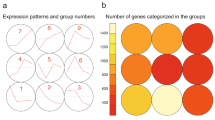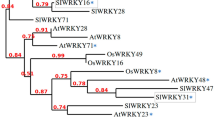Abstract
A group of plant proteins, expansins, have been identified as wall-loosening factors and as facilitators of cell expansion in vivo. The root knot nematode Meloidogyne javanica establishes a permanent feeding site composed of giant cells surrounded by gall tissue. We used quantitative PCR and in situ localization to demonstrate the induction of a tomato (Lycopersicon esculentum cv. VF36) expansin (LeEXPA5) expression in gall cells adjacent to the nematode feeding cells. To further characterize the biological role of LeEXPA5 we have generated LeEXPA5-antisense transgenic roots. The ability of the nematode to establish a feeding site and complete its life cycle, the average root cell size and the rate of root elongation were determined for the transgenic roots, as well as the level of LeEXPA5 expression in non-infected and nematode-infected roots. Our results demonstrated that a decrease of LeEXPA5 expression reduces the ability of the nematode to complete its life cycle in transgenic roots. We suggest that a plant-originated expansin is necessary for a successful parasitic nematode–plant interaction.


Similar content being viewed by others
Abbreviations
- CBD:
-
Cellulose binding domain
- d.p.i:
-
Days post inoculation
- E:
-
LeEXPA5-antisense transgenic lines
- GFP:
-
Green fluorescence protein
- GLM:
-
General linear model
- PCR:
-
Polymerase chain reaction
- qPCR:
-
Quantitative PCR
- RT:
-
Reverse transcription
References
Bar-Or C, Kapulnik Y, Koltai H (2005) A broad characterization of the transcriptional profile of the compatible tomato response to the plant parasitic root knot nematode Meloidogyne javanica. Eur J Plant Pathol 111:181–192
Brummell DA, Harpster MH, Civello PM, Palys JM, Bennett AB, Dunsmuir P (1999a) Modification of expansin protein abundance in tomato fruit alters softening and cell wall polymer metabolism during ripening. Plant Cell 11:2203–2216
Brummell DA, Harpster MH, Dunsmuir P (1999b) Differential expression of expansin gene family members during growth and ripening of tomato fruit. Plant Mol Biol 39:161–169
Chen F, Dahal P, Bradford KJ (2001) Two tomato expansin genes show divergent expression and localization in embryos during seed development and germination. Plant Physiol 127:928–936
Cosgrove DJ (1999) Enzymes and other agents that enhance cell wall extensibility. Annu Rev Plant Physiol Plant Mol Biol 50:391–417
Davis EL, Hussey RS, Baum TJ (2004) Getting to the roots of parasitism by nematodes. Trends Parasitol 20:134–141
Daykin ME, Hussey RS (1985) Staining and histopathological techniques in nematology. In: Barker KR, Carter CC, Sasser JN (eds) An advanced treatise on Meloidogyne, vol 2, methodology. Department Plant Pathol, North Carolina State University, Raleigh, pp 39–48
Gal TZ, Glazer I, Koltai H (2003) Differential gene expression during desiccation stress in Steinernema feltiae IS6. J Parasitol 89:761–766
Gamborg OL, Miller RA, Ojima K (1968) Nutrient requirements of suspension cultures of soybean root cells. Exp Cell Res 50:151–158
Gheysen G, Fenoll C (2002) Gene expression in nematode feeding sites. Annu Rev Phytopathol 40:191–219
Goellner M, Smant G, De Boer JM, Baum T J, Davis EL (2000a) Isolation of beta-1,4-endoglucanase genes from Globodera tabacum and their expression during parasitism. J Nematol 32:154–165
Goellner M, Shani Z, Shoseyov O, Davis EL (2000b) Plant endoglucanase expression in cyst and root knot nematode-induced feeding cells. Phytopathology 90:S28
Goellner M, Wang XH, Davis EL (2001) Endo-beta-1,4-glucanase expression in compatible plant–nematode interactions. Plant Cell 13:2241–2255
Golecki B, Fudali S, Wieczorek K, Grundler FMW (2002) Identification and localisation of tomato expansin gene expression in nematode-induced syncytia. Nematology 4:219
Han B, Linden JC, Gujarathi NP, Wickramasinghe SR (2004) Population balance approach to modeling hairy root growth. Biotechnol Prog 20:872–879
Haseloff J, Siemering KR (1998) The uses of green fluorescent protein in plants. In: Chalfie M, Kain S (eds) Green fluorescent protein: properties, applications, and protocols. Wiley-Liss, New York, pp 191–220
Kende H, Bradford K, Brummell D, Cho HT, Cosgrove D, Fleming A, Gehring C, Lee Y, McQueen-Mason S, Rose J, Voesenek LA (2004) Nomenclature for members of the expansin superfamily of genes and proteins. Plant Mol Biol 55:311–314
Koltai H, Bird DMcK (2000) High throughput cellular localization of specific plant mRNAs by liquid-phase in-situ reverse transcription-polymerase chain reaction of tissue sections. Plant Physiol 123:1203–1212
Koltai H, Bird DMcK (2002) Recovery and sequence validation of the histological signal following in-situ RT-PCR localization of plant gene transcription. Plant Mol Biol Rep 20:391–397
McQueen-Mason S, Durachko DM, Cosgrove DJ (1992) Two endogenous proteins that induce cell wall expansion in plants. Plant Cell 4:1425–1433
McQueen-Mason S, Cosgrove DJ (1995) Expansin mode of action on cell walls. Analysis of wall hydrolysis, stress relaxation, and binding. Plant Physiol 107:87–100
Pesquet E, Barbier O, Ranocha P, Jauneau A, Goffner D (2004) Multiple gene detection by in-situ RT-PCR in isolated plant cells and tissues. Plant J 39:947–959
Plovie E, De Buck S, Goeleven E, Tanghe M, Vercauteren I, Gheysen G (2003) Hairy roots to test for transgenic nematode resistance: think twice. Nematology 5:831–841
Qin L, Kudla U, roze EHA, Goverse A, Popeijus H, Nieuwland J, Overmars H, Jones JT, Schots A, Smant G, Bakker J, Helder J (2004) Plant degradation: a nematode expansin acting on plants. Nature 427:30
Rochange SF, Wenzel CL, McQueen-Mason S (2001) Impaired growth in transgenic plants over-expressing an expansin isoform. Plant Mol Biol 46:581–589
Shani Z, Dekel M, Tzbary G, Shoseyov O (1997) Cloning and characterization of elongation specific endo-1,4-β-glucanase (cel 1) from Arabidopsis thaliana. Plant Mol Biol 34:837–842
Shani Z, Dekel M, Sig-Jensen C, Tzfira T, Goren R, Altman A, Shoseyov O (2000) Arabidopsis thaliana endo-1,4-β-glucanase (cel1) promoter mediates uidA expression in elongating tissues of aspen (Populus tremula). J Plant Physiol 156:118–120
Shpigel E, Roiz L, Goren R, Shoseyov O (1998) Bacterial cellulose-binding domain modulates in vitro elongation of different plant cells. Plant Physiol 117:1185–1194
Sobczak M, Fudali S, Golecki B, Janakowski S, Grymaszewska G, Kurek W, Lichocka M, Grundler FMW, Golinowski W (2002) Localisation of expression of Le-Exp5 in feeding sites induced by Globodera rostochiensis in roots of susceptible tomato using in-situ RT-PCR method. Nematology 4:225
Vercauteren I, de Almeida Engler J, De Groodt R, Gheysen G (2002) An Arabidopsis thaliana pectin acetylesterase gene is up-regulated in nematode feeding sites induced by root-knot and cyst nematodes. Mol Plant Microbe Interact 15:404–407
Williamson VM, Hussey RS (1996) Nematode pathogenesis and resistance in plants. Plant Cell 8:1735–1745
Zareen A, Siddiqui IA, Aleem F, Zaki MJ, Shahid-Shaukat S (2001) Observations on the nematicidal effect of Fusarium solani on the root-knot nematode, Meloidogyne javanica. J Plant Pathol 83:207–214
Acknowledgments
Tali Z Gal and Elitsur R. Aussenberg contributed equally to this work. This work was supported by an Israeli Science Foundation Grant (number 522/02-1) to HK and YK. We thank Dr. Jim Haseloff (Department of Plant Sciences, University of Cambridge, UK) for donating the pBIN m-gfp5-ER plant transformation vector and Dr. Ruth Markus and Mrs. Miri Zarhi from the Department of Statistics at the Volcani Center for the statistical analysis.
Author information
Authors and Affiliations
Corresponding author
Rights and permissions
About this article
Cite this article
Gal, T.Z., Aussenberg, E.R., Burdman, S. et al. Expression of a plant expansin is involved in the establishment of root knot nematode parasitism in tomato. Planta 224, 155–162 (2006). https://doi.org/10.1007/s00425-005-0204-x
Received:
Accepted:
Published:
Issue Date:
DOI: https://doi.org/10.1007/s00425-005-0204-x




